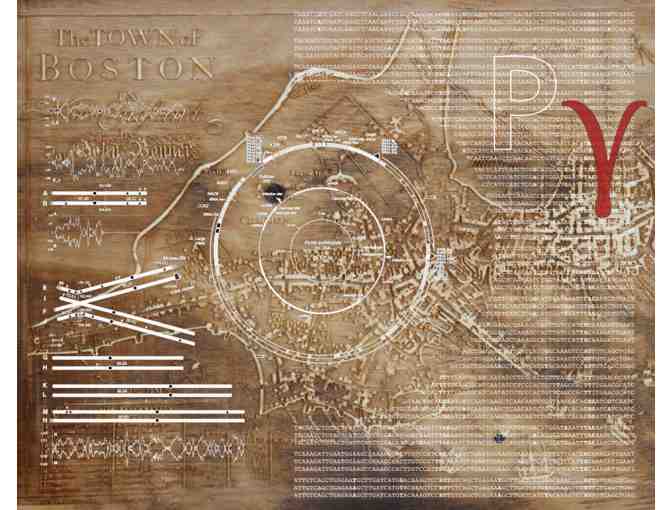Art
Benjamin Walker - Boston
- Item Number
- 9
- Estimated Value
- Priceless
- Opening Bid
- 200 USD
Item Description
ARTIST: Benjamin Walker
TITLE: Boston
MEDIUM: Laser-cut plexi and wood, 14” x 18”, unframed
This original artwork was created for Art on Science: 26 études an internattional portfolio featuring pictures by artists and words by scientists. This written commentary is by Jean-Luc Souciet, Biology Department of Musée Zoologique de Strasbourg:
A genetic map is like a street map of a city: streets are labeled and buildings numbered. The chromosomes of all living beings are linear sequences of four chemical ‘letters’, the fourbases A (adenine), C (cytosine), G (guaniine), T (thymine). The combinatorial use of this alphabet will produce the genes that we are able to identify by scanning each chromosome, hence the name of chromosome map.
But we can discover more. There are the maps that give an understanding at first glance and there is then thequestioning of what lies beneath the maps…if we could make them ‘talk’, what would they reveal about the society which they represent? The process of hybridization between different individuals is the confrontation of two different chromosomal maps. This ‘confrontation’ creates a rupture, often lethal, and of the new genetic combinations that survive, they do not tend to last very long. For artists it can be similar; they meet each other in a confrontation of style and vision. Many will stop abruptly, but sometimes inspiration (hybridization?) will inform a new movement or style and have influence on future generations.
Cities like Strasbourg and Boston were built, in part, with the trade of salt, primarily as a food preservative. Pichia sorbitophila has an affinity for salt and thrives in a saline environment. The graphic representation of these two cities dates to about 300 years ago (1689 for Strasbourg and 1720 for Boston), which corresponds to the origin of the hybridization of the two parental genomes (P γ and P ε) of Pichia sorbitophila, and therefore the origin as a unique bacterial species.
Item Special Note
Free domestic shipping.
All artworks are 16” x 20”, unframed and will be shipped with a printed copy of the scientist’s text.
For further information about the portfolio, please visit our Art on Science: 26 études website: http://AS26project.com
Mosesian Center for the Arts stores data...
Your support matters, so Mosesian Center for the Arts would like to use your information to keep in touch about things that may matter to you. If you choose to hear from Mosesian Center for the Arts, we may contact you in the future about our ongoing efforts.
Your privacy is important to us, so Mosesian Center for the Arts will keep your personal data secure and Mosesian Center for the Arts will not use it for marketing communications which you have not agreed to receive. At any time, you may withdraw consent by emailing Privacy@frontstream.com or by contacting our Privacy Officer. Please see our Privacy Policy found here PrivacyPolicy.

